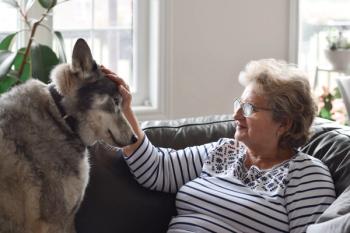
Awareness, cost of care driving visits down, study says
National Report - In the last three years, James Dee, DVM, has seen visits steadily drop in his hollywood, Fla., practice. In fact, the appointment calendar is wide open. "Anybody can be seen within a day," he says.
NATIONAL REPORT — In the last three years, James Dee, DVM, has seen visits steadily drop in his Hollywood, Fla., practice. In fact, the appointment calendar is wide open. "Anybody can be seen within a day," he says.
He is not alone.
Though the pet population continues to grow in the United States, fewer dogs and cats are visiting the veterinarians each year, often due to a lack of owner awareness of the necessity of annual visits and the perceived high cost of veterinary care, according to a new study conducted by the National Commission on Veterinary Economic Issues, Brakke Consulting and Bayer Animal Health.
"Many pet owners don't understand the need for exams because they are so vaccine focused," says John Volk, senior consultant at Brakke Consulting. "It is the single most significant [factor], especially in terms of things vets can do something about."
Dee agrees. "You have to express value in what you are doing for the pet," he says. "(The client) has to realize there is value in the examination."
The Bayer Veterinary Care Usage Study was conducted in multiple stages, including a literature review, interviews with veterinarians and pet owners and finally a representative survey of more than 2,000 dog and cat owners across the United States.
The survey identified six causes for fewer vet visits, including misperceptions related to the necessity of exams, fragmentation of services, the cost of care, declining incomes and unemployment, the Internet and feline resistance.
Findings were generally consistent across demographics, Volk says, with only minor differences peppering the data. "There was a slight tendency for more lapsed visits in areas harder hit by the recession, such as the rust belt ... or by people who were unemployed or had incomes below $35,000 in the household. That reinforces the recession's impact," he says. "But really, it's an endemic problem across the USA."
Florida has been particularly hard hit by the recession, and Dee's practice has felt the effects too. Visits dropped 5 percent in 2009 versus 2008 and another 3 percent in 2010 compared with the prior year.
Because pet owners are associating visits with vaccines, available services at non-traditional clinics, such as animal shelters, pet stores and vaccination clinics, may be reducing annual vet visits. The study's backers say education is the most important tool in reversing the declining visits trend. "We need a clear mandate about what constitutes good pet care," says Dr. Karen Felsted, CEO of NCVEI.
To that end, the groups propose creating and standardizing animal-care guidelines. "There are no established guidelines for what represents good pet health care," says Ian Spinks, president and general manager of Bayer Animal Health North America.
While Volk agrees, he also points out that the frequency of visits can be addressed even before the veterinary community agrees on an animal-beneficial schedule. "The first thing vets have to do is monitor what their visits are," he says. "In interviews with vets, many don't track their visits, only revenues and average transaction charges. They're not tracking visits and don't know what kind of store traffic they have. If they don't know what it is, they don't know if it's declining or improving." However, of those who did regularly track visits, 56 percent of veterinarians reported fewer visits in 2010 versus 2009.
The cost of care
When it comes to cost, the survey revealed that 53 percent of respondents were surprised by the cost of their pet's health care and found it higher than they expected. "In analyzing the research, one of the things that became clear is that veterinarians need to help pet owners understand costs," Volk says. For more expensive treatments, he advises educating owners as to available resources, such as emergency funding, loans and financing programs.
The pricing structure in the veterinary community also plays a role, Felsted says. The long-standing approach of taking last year's fees and adding 5 to 15 percent may not be the most effective tool. "There are tons of pricing models and techniques used in other industries," she says. "It's all very doable, but it takes some time and retraining about how we do things."
Volk advises starting small to increase visits by looking at the appointment calendar and using open appointments to try to book lapsed clients. "Use slow days to reach out to pets who haven't been in in more than a year," he says. He also emphasizes the importance of best practices when clients are in the clinic, such as scheduling the next appointment before a client has walked out the door.
Ups and downs online
As with human medicine, many pet owners look to the Internet for information before scheduling a veterinary visit. In the study, some 15 percent of respondents said that because of the Internet, they do not rely on veterinarians as much and 39 percent look online for information before consulting a DVM. "Many (clients) go to the Internet and get information, and for some animals, when the vet sees them, (the pet) should have been brought in earlier," says Volk. "One vet said in the study, 'We're seeing pets three days sicker.' "
However, Felsted notes, "The Internet has been a great thing for us because of the information available. But, some is the opinion of the person who wrote it, and it has no scientific basis behind it." She emphasizes the need for directing clients to reliable information. "One thing we can do is help them understand where they can get credible information," she says. "Let's direct them to somewhere where they can get (that information)."
Feline resistance
Cats are visiting the veterinarian more infrequently than dogs, according to the study. In fact, one third of cat owners had not taken their pet to the vet in more than a year.
The trend is unsettling, Felsted adds.
The resistance to seeking veterinary care for cats is attributed to the stress-related behavior of the experience — from placing the cat in the carrier to release following the visit.
To remedy the issue, she recommends making the practice more cat friendly and also encouraging the owner. "Part of it is making (a visit) easier on the cat, but also, there's the perception of the cat owner," she notes. "Because if the cat owner feels guilty about Fluffy being stressed, they're not going to bring (the cat) in."
In the clinic, Felsted says groupings of chairs or screens to separate cats and dogs can be very effective, as can ensuring an exam room is immediately available upon a cat's entry. For the owners, she recommends education related to acclimating cats to carriers to reduce the association between the carrier and a trip to the veterinarian.
While the study revealed a variety of concerns for the veterinary industry, Volk is optimistic. "There is a lot of good news in this study for vets because there are reasons for optimism," he says. "The trends can be reversed, and there are things that can be done today."
Ms. Karapetian is a freelance writer in Chicago.
Newsletter
From exam room tips to practice management insights, get trusted veterinary news delivered straight to your inbox—subscribe to dvm360.




